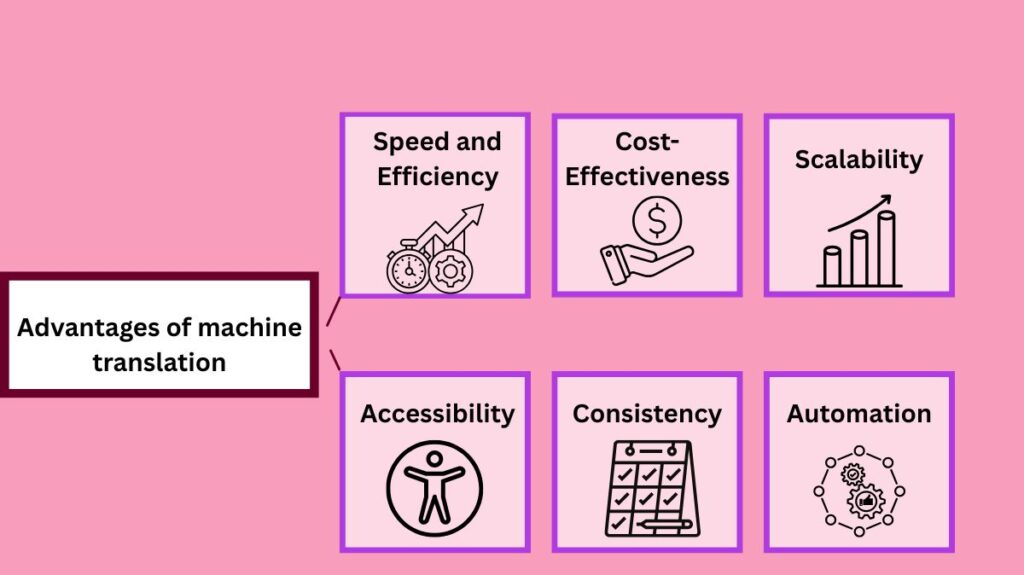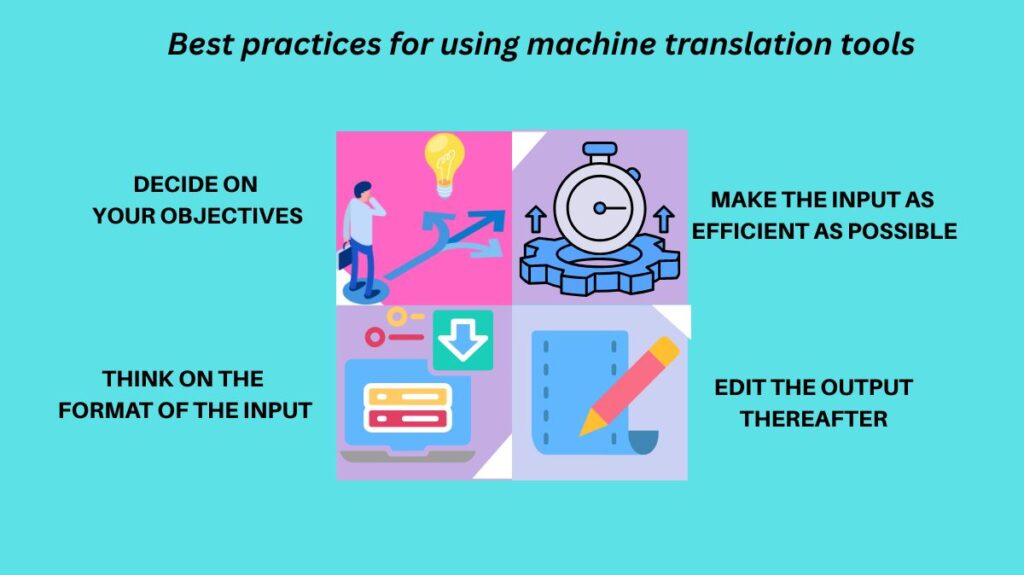Advantages and disadvantages of machine translation
Advantages of machine translation

- Speed and Efficiency: Automated translation speeds up information distribution by translating enormous amounts of material faster than human translators.
- Cost-Effectiveness: It can be more cost-effective than human translation, particularly for preliminary or large-volume translations.
- Scalability: Machine translation systems can handle large amounts of text and numerous languages simultaneously.
- Accessibility: Overcoming language barriers makes knowledge accessible to more people.
- Consistency: Machine translation maintains consistent language and style, something human translators struggle with.
- Automation: Human translators can focus on post-editing and nuanced interpretation with automated translation.
Learn more about How Does Sentiment Analysis Work In NLP, Its Types & Levels
Disadvantages of machine translation
- Inaccuracy: Complex language, colloquial words, and cultural differences can cause machine translation errors.
- Lack of Context: Lack of context may cause sentence misreading.
- Cultural Sensitivity: Due to cultural sensitivity, machine translation may miss nuanced cultural nuances and connotations in a text.
- Bias: Machine translation models can be biased due to biases in training data, resulting in faulty or unfair translations.
- Difficulty with Specialized Fields: In specialised professions like law or medical, machine translation may be inaccurate and require human post-editing and specialised models.
- Privacy Concerns: Translating confidential material utilising free machine translation services can provide a danger of data leaks.
- Limited Vocabulary: Machine translation models may have limited vocabulary, particularly for uncommon languages or new terminology.
- Lack of Creativity: Machines may struggle to convey a text’s emotion, which may affect translation quality and comprehension.
Use cases of machine translation
Numerous industries stand to gain from machine translation.
- Tourism and travel. When visiting a foreign nation, people can interact with ease using machine translation technology instead of relying on human interpreters.
- International business and e-commerce. Online firms can expand their customer base globally with the aid of machine translation. It makes it simpler for customers to comprehend and purchase goods by automatically translating product descriptions, reviews, and even customer service. In order to communicate with people worldwide, it also facilitates the adaptation of software, websites, and marketing content to other languages and cultural norms.
- Publishing and the media. Machine translation enables written information, like blogs and news stories, to reach a worldwide audience. It breaks down language barriers and improves communication with readers by making information translation and distribution quick and simple.
- Customer service and support. Machine translation improves the customer care experience by translating customer communications instantly, whether they take place over the phone or through online chats.
- Medical research and healthcare. Machine translation is essential for translating medical records, research publications, and patient data. It improves communication and information access by bringing together researchers and medical experts from around the globe.
Learn more about What Is Text Extraction? Advantages, Types And Applications
Machine translation challenges
- Particularly when it comes to accuracy, cultural quirks, colloquial idioms, and subjective content, machine translation isn’t flawless and has to be improved.
- Context understanding remains a challenge for machine learning systems. The cost of machine translation may increase if professional translators are required to guarantee accuracy and precision of translations.
- Domain-specific and linguistic models are needed for accurate machine translation in law and medicine.
- Furthermore, cultural and gender biases in the training data may be reflected in machine translation software, leading to erroneous translations. Due to insufficient training data, it also struggles with unusual languages.
However, machine learning and natural language processing will increase, reducing technical restrictions. Research on machine translation is still underway, with attempts to solve the aforementioned issues and enhance translation quality continuing.
Leading machine translation tools
Know the machine translation use case before choosing a tech. These popular tools are versatile and suitable for diverse use cases:
- Google Translate dominates computer translation. Over 100 languages are supported by this free tool. Google Translate improves accuracy using NMT by learning from vast data sets.
- DeepL, another accurate machine translation application, is popular. It employs an NMT model trained on a vast collection of text and code, and it supports more than 26 languages. Although DeepL is a premium product, a free trial is available.
- Microsoft Translator is a free machine translation application that covers over 60 languages. Because it employs an SMT model, text translation is based on statistical data. Although it might not be as accurate as NMT-based technologies, Microsoft Translator is an excellent choice for straightforward translations.
- Free machine translation technology Yandex Translate covers 90+ languages. It makes use of an NMT model trained on a big corpus of code and text. For general-purpose translations, Yandex Translate is a decent choice, but for certain languages or domains, it might not be as accurate as some other programs.
- With capability for more than 200 languages, Amazon Translate is a commercial machine translation service. It makes use of an NMT model that was trained using a sizable corpus of code and text. For companies who need to translate a lot of content or that wish to personalise their translations, Amazon Translate is an excellent choice.
- Using hybrid machine translation technology, Systran, which was established 55 years ago, offers machine translation software. It delivers accurate translations with adaptable, sector-specific solutions by combining rule-based and neural machine translation techniques.
Best practices for using machine translation tools

You may maximize the use of your machine translation technologies and generate high-quality translations by adhering to these four recommended practices.
- Decide on your objectives. With machine translation, what goals do you hope to accomplish? Do you require a more precise translation for a particular use, like integrating MT into your models, or are you translating for general comprehension?
- Think on the format of the input. Machine translation works well with certain text types. Google Translate is good at translating short sentences, but DeepL is better at larger, more complex texts. Choose the correct tool for your task.
- Make the input as efficient as possible. By optimizing the input, machine translation can produce higher-quality results. This include properly formatting the content, eliminating any mistakes, and, if at all possible, adding context.
- Edit the output thereafter. There are automated editing systems that can handle this, but even the greatest machine translation techniques may generate output that requires human translation post-editing. This is particularly valid for technical or delicate information.
Learn more about The History Of Machine Translation MT And How Does It Work?
